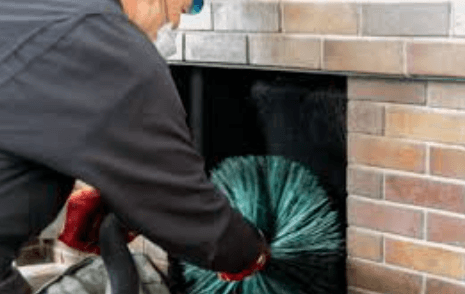Pros and Cons of Chimney Cleaning Logs

Is there anything better than a cozy winter evening inside, bundled next to a crackling fire with a cup of hot cocoa? A wood-burning fireplace adds a warm and luxurious feel to any room. But while everyone basks in a fireplace’s ambiance, few consider the cleaning aspect of owning one.
Keeping your wood fireplace clean is necessary for many reasons. Creosote buildup is a significant fire hazard and blocked chimneys can lead to deadly carbon monoxide poisoning. Ideally, you should be having your fireplace chimney cleaned annually by a professional. However, buildup can still occur between visits.
One way to maintain your chimney’s cleanliness between sweepings is to use chimney cleaning logs. In this guide, you’ll learn how CSLs work, and the pros and cons of chimney cleaning logs.
How Chimney Cleaning Logs Work
When wood burns in a fireplace, one of the byproducts of that fire is a substance called creosote. Creosote travels up through the chimney as a gas and then condenses into a sticky and oily substance that adheres to the sides of the chimney. This substance is extremely flammable and can catch fire from a single errant spark.
Cleaning logs are logs that are coated in a chemically-treated exterior. When this exterior burns, it produces a chemical that attaches to creosote deposits. The creosote breaks down into a powder that then falls into your fireplace, where you can sweep it out before setting up your next fire.
Using cleaning logs is easy. You simply set the fire, let it burn for at least two hours, and then remove any fallen creosote from the fireplace. While cleaning logs likely won’t entirely remove all the creosote from your chimney, they will make whatever’s leftover extremely easy to remove manually.
Note that not all cleaning logs can be used with all fireplaces. Check the logs’ packaging before use to ensure they work with your fireplace.
See also: Navigating the Terrain: Personal Injury Attorneys and Insurance Companies
Pros of Chimney Cleaning Logs
The number one advantage of utilizing chimney cleaning logs is that they are simple and easy to use. Simply set them on fire in your fireplace and let them go to work.
The second advantage, but equally important to the first, is that they help prevent chimney fires. There are an estimated 25,000 chimney fires in the United States each year, causing damages totaling in the millions.
Using cleaning logs in your fireplace can help improve your home’s air quality. Dirty chimneys have reduced airflow, so smoke and carbon monoxide could be escaping into your home. Using CSLs once a month can keep chimneys clear and flowing.
Chimney Cleaning Log Cons
The biggest downside of using CSLs is that they don’t replace a full cleaning by a professional. So even if you burn cleaning logs once per month, you still must have to get your annual service. Since chimney cleaning logs don’t replace the need for annual service, they wind up costing you more money rather than saving any.
The second downside is that since cleaning logs don’t necessarily fully remove the creosote, there’s still a chance it could catch fire in your chimney. The only way to prevent a fire is to remove the creosote manually.
Finally, CSLs can sometimes give off an unpleasant odor as the chemically treated exterior burns. There are no dangerous gasses, but it can be unpleasant.
Chimney sweeping logs can be a great tool for maintaining the cleanliness of your fireplace. Now that you know the benefits and downsides of for chimney cleaning logs, you’re well-positioned to decide if they’re right for your home.




